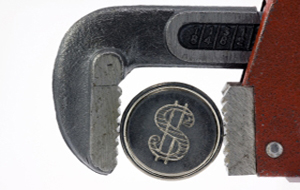
After 10 years of losing value, 2014 saw the U.S. dollar climb back up on the back of an improving economy. And as Institutional Investor’s Rosalyn Retwa reports, currency-hedged international exchange-traded funds (ETFs) are drawing in new money as investors seek to protect themselves against the impact of the dollar’s resurgence relative to other currencies such as the yen and euro, both of which are on the decline.
As the article points out, between 2000 and 2010, the dollar lost 40% of its value giving a big boost to investors with unhedged allocations to the MSCI EAFE, which gained 45% through currency exposure. The index itself delivered very weak returns during the same period.
Of course, Canadian investors during that time had the opposite problem, with the loonie beginning a steady climb that saw it rise close to parity with the U.S. dollar, making it harder for investors here with unhedged exposure to international assets.
The article makes the point that hedged ETFs have outperformed the unhedged version of the same product, at least over the last year. Here’s how it breaks down:
The Deutsche X-trackers MSCI EAFE Hedged Equity ETF (DBEF) year-to-date through Nov. 30, DBEF had a 6.94% gain in net asset value, whereas the unhedged version of the MSCI EAFE index was down 1.49%.
Last January, iShares started offering hedged versions of three of its international equity ETFs.
A hedged version of the iShares MSCI Japan ETF (EWJ)—HEWJ, a hedged version of the iShares MSCI Germany ETF (EWG)—HEWG, and a hedged version of the iShares MSCI EAFE ETF (EFA)—HEGA.
Year-to-date, the unhedged versions had total return losses while the hedged versions all gained. According to the article:
The EWJ fell 2.99%, EWG lost 6.31%, and EFA dropped 1.62%. From the Jan. 31 launch of the hedged versions through Nov. 30, HEWJ posted a total return gain of 19.84%, HEWG gained 7.09%, and HEFA climbed 11.69%.
So does this mean Canadian plan sponsors should consider hedging their currency—and possibly through ETFs?
The answer is, as always, tricky in a pension context.
To gain more insight, I dug back into the Canadian Investment Review archives and found this 2010 blog post by Dave Lawson, chief investment officer at the Workers’ Compensation Board – Alberta.
Those that hedge, according to Lawson, typically claim they are doing so to reduce short-term volatility. Those that don’t claim it’s a zero-sum gain and that it all washes out in the end. Moreover, many say the cost of hedging isn’t worth it.
As Lawson points out, the case for hedging against short-term volatility failed spectacularly in the 2008 crisis as returns on unhedged foreign equities for Canadian investors were far better than they were for unhedged—MSCI World Ex Canada unhedged versus hedged was -25.8% versus -41.0%, notes Lawson.
Is that just a random event?
Lawson offers up some insights from a paper by John Y. Campbell and a team of Harvard authors—Global Currency Hedging, published on Sept. 5, 2007, revised January 2009, John Y. Campbell, Karine Serfaty-de Medeiros, and Luis M. Viceira). The authors make the argument that hedge ratios should differ between reserve currencies and non-reserve currencies, and it is an argument with a lot of intuitive appeal. As Lawson writes:
“The basic idea from a Canadian perspective, is that the hedge ratio versus the U.S. dollar should be lower than the hedge ratio on other major currencies. This is because the U.S. dollar is the global reserve currency, at least for the foreseeable future, and it will always get a flight to quality or risk aversion rally when there is stress in global financial markets. This makes the global reserve currency unique when setting an optimal hedge ratio.
The lesson learned is that, for Canadian investors, there may be a strong case for a lower hedge ratio on the U.S. dollar than other foreign currencies. In times of financial market stress, a strengthening U.S. dollar will partially offset negative equity market returns.
The timing of any change in hedge ratios is a tactical decision and should be done very carefully, but very much as a separate decision from the long-term policy-hedging decision.
The lesson for Canadian plan sponsors?
The growing ETF universe offers a greater range of hedged products, which is good news for investors looking to hedge their currencies. But for Canadian plan sponsors, products linked with reserve currencies might be the best hedge against currency volatility. They might do well to consider choosing on that basis.
And when they do, hedged ETFs are a cheap and liquid option for pension investors to add a hedge if and when they want to.
In the meantime, however, the falling Canadian dollar makes it a lot easier to ride out the ups—and especially the downs—of currency fluctuations.
